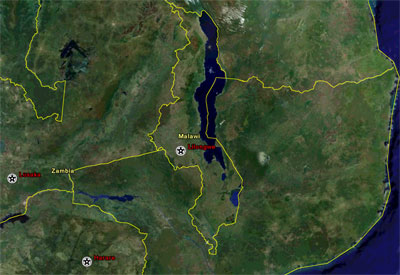MALAWI
Please note, this page is not longer being updated. For more recent information, please see news.mongabay.com and use the search function to find the country feed. For more up-to-date data on forest cover and loss, check out Global Forest Watch.
| Malawi Forest Figures
Forest Cover Total forest area: 3,402,000 ha % of land area: 36.2% Primary forest cover: 1,132,000 ha % of land area: 12.0% % total forest area: 33.3% Deforestation Rates, 2000-2005 Annual change in forest cover: -33,000 ha Annual deforestation rate: -0.9% Change in defor. rate since '90s: 9.6% Total forest loss since 1990: -494,000 ha Total forest loss since 1990:-12.7% Primary or "Old-growth" forests Annual loss of primary forests: -39600 ha Annual deforestation rate: -3.0% Change in deforestation rate since '90s: 29.5% Primary forest loss since 1990: -198,000 ha Primary forest loss since 1990:-34.5% Forest Classification Public: n/a Private: n/a Other: n/a Use Production: n/a Protection: n/a Conservation: n/a Social services: n/a Multiple purpose: n/a None or unknown: n/a Forest Area Breakdown Total area: 3,402,000 ha Primary: 1,132,000 ha Modified natural: 2,067,000 ha Semi-natural: n/a Production plantation: 204,000 ha Production plantation: n/a Plantations Plantations, 2005: 204,000 ha % of total forest cover: 6% Annual change rate (00-05): 4,800,000 ha Carbon storage Above-ground biomass: 260 M t Below-ground biomass: 62 M t Area annually affected by Fire: n/a Insects: n/a Diseases: n/a Number of tree species in IUCN red list Number of native tree species: n/a Critically endangered: 0 Endangered: 2 Vulnerable: 6 Wood removal 2005 Industrial roundwood: 655,000 m3 o.b. Wood fuel: 5,617,000 m3 o.b. Value of forest products, 2005 Industrial roundwood: n/a Wood fuel: n/a Non-wood forest products (NWFPs): n/a Total Value: n/a More forest statistics for Malawi |
Deforestation is a serious problem in Malawi. Between 1990 and 2005, the country lost nearly 13 percent of its total forest cover due to fuelwood collection and subsistence and commercial agriculture. Tobacco farming, which accounts for nearly 80 percent of the nation's export earnings (Trade Environment Database: Malawi Tobacco Industry and the Environment), is sometimes blamed for deforestation, but perhaps more importantly, it saps the country's economy. The nation's heavy reliance on the commodity has certainly weakened the overall economy by leaving it highly vulnerable to decreasing tobacco prices while impacting the health of rural farmers who grow the cash crop instead of food crops.
Malawi—a land-locked nation—is home to Lake Malawi which houses some of the greatest fish diversity of any lake on earth, but deforestation has resulted in soil erosion and siltation of parts of the lake.
Malawi's loss of primary tropical forest is of great concern to conservationists. Between 2000 and 2005, the country lost almost 35 percent of its primary forest cover. This loss threatens Malawi's tremendous potential for eco-tourism, which could be based on its famous lake and safari wildlife.
As of 2004, about 16 percent of Malawi was under some form of protection. The country is home to 658 species of birds, 108 mammals, 207 reptiles, 56 amphibians, and 3,765 species of plants. Recent articles | Malawi news updates | XML
Suggested reading - Books
- Spectrum Guide to Malawi
- The Bradt Travel Guide to Malawi
- Adventuring in Southern Africa: The Great Safaris and Wildlife Parks of Botswana, Zimbabwe, Zambia, Namibia, South Africa, Malawi, Lesotho, and Swaziland
- Birds of Eastern Africa
Unless otherwise specified, this article was written by Rhett A. Butler [Bibliographic citation for this page]
Other resources
Contact me if you have suggestions on other rainforest-related environmental sites and resources for this country.

Image copyright Google Earth, MDA EarthSet, DigitalGlobe 2005
CIA-World Factbook Profile
FAO-Forestry Profile
World Resources Institute
Last updated: 4 Feb 2006
